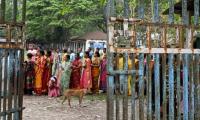KARACHI: The central bank on Monday emphasised ‘deep rooted structural reforms’ to reinforce the current stabilisation agenda in the wake of persisting economic challenges, including deteriorating fiscal deficit, inflation spike and moderate growth.
“With stabilisation policies in place and the economy moving along the reforms agenda, the country’s macroeconomic indicators are expected to slowly revert to a stable trajectory,” the State Bank of Pakistan (SBP) said in the third quarterly report on state of economy for FY2019. “In this process, however, the real GDP growth is likely to remain contained.”
The SBP said the economy has remained in the stabilisation phase for the last 16 months owing to demand management policies, but it is still facing three challenges: “external sector remains vulnerable. Fiscal consolidation remains elusive. Inflation continues to attain higher plateaus.”
The central bank said consumer inflation averaging at 6.8 percent in the first nine months of FY2019 has already exceeded six percent. GDP growth moderated to 3.3 percent in the last fiscal year.
“Thus far, these trends have yet again exposed Pakistan’s structural deficiencies and its vulnerabilities to the buildup of external and internal deficits.” The SBP said the pace of economic growth slowed down considerably during FY19, mainly in response to policy measures taken to curb the twin deficits.
“These measures affected the performance of the industrial sector and dampened manufacturing activities in the country.” The SBP is, however, expecting some support to GDP from agriculture sector “where there is a potential for higher output if the impact of constraints affecting area under cultivation and yields is managed effectively”.
“Early investments in agriculture and SEZs (special economic zones) under the CPEC (China-Pakistan Economic Corridor) and higher outlay of next year’s PSDP (public sector development program) can also have a positive impact on GDP growth in FY20.”
The SBP said inflation remained stubborn due to cost-push factors, including exchange rate depreciation and increase in energy prices, although demand-pull pressures eased towards the end of FY2019. The headline consumer price index inflation rose steeply from 6 percent in H1-FY19 to 8.3 percent in the third quarter.
The SBP is seeing downside risks to the government’s projection of lower current account deficit in the current fiscal year of 2019/20 on better performance of export sector, continued momentum of remittances, and slowdown in imports.
“However, downside risks persist in the wake of a slowdown in global economy, attributed to escalated trade war between US-China and uncertainty in Europe,” the SBP said. “Under these circumstances, increasing exports to the traditional markets may prove challenging.”
The SBP said the International Monetary Fund’s extended fund facility would help assuage the overall external sector’s concerns.
The SBP said revenue mobilisation remained weak due to stagnant tax revenues and steep fall in non-tax revenues. “These trends are largely attributed to slowdown in economic activity and lack of tax effort both at provincial and federal level,” it added. “As a result, the fiscal deficit increased to 5.0 percent of GDP; notably, the primary deficit has risen to 1.2 percent of GDP, which suggests that the debt servicing ability has deteriorated sharply and the country would be requiring more debt to service its current debt.”
Saad was of the view that the battle of politics should be fought solely through political means
KP govt decided to develop gemstone business as a formal export sector and cluster at the Namak Mandi would be...
Khyber Pakhtunkhwa Minister for Higher Education, Archives, and Libraries, Meena Khan Afridi. — APP FilePESHAWAR:...
Vehicles and horse carts passing through flood water at Bara Bazar area on Khuwani bridge after heavy rain in Peshawar...
Amid the failure to revive the cash-bleeding PIA, government is left with no other option but to sell it to any...
Picture showing the Silver Jubilee Gate of the University of Karachi. — APP File KARACHI: The University of Karachi...







